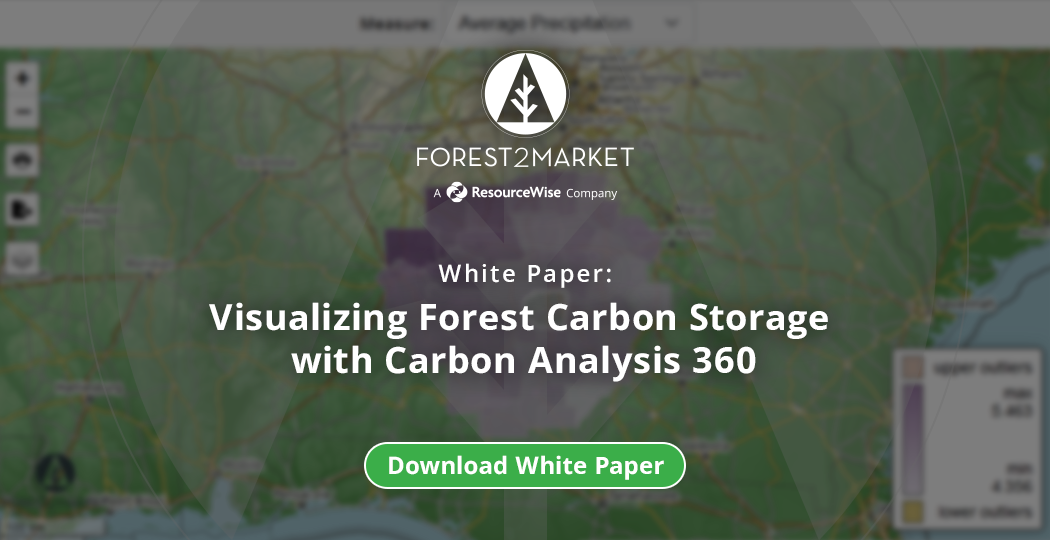4 min read
What Forest Carbon Pool Types Store the Most Carbon in the US?
John Greene
:
September 14, 2022
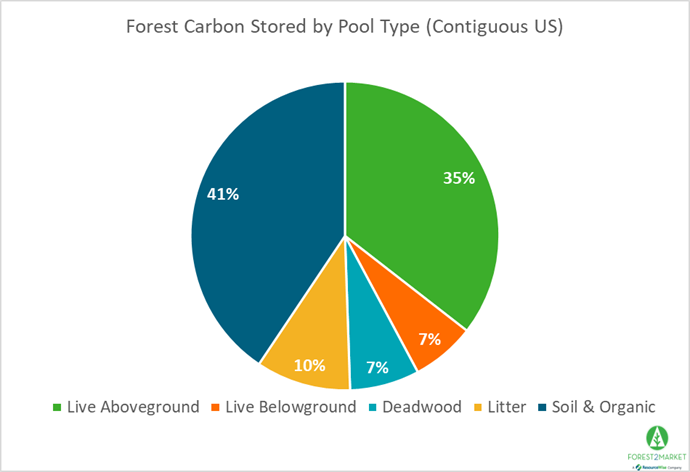
Forest2Market’s newest analytical tool – Carbon Analysis 360 – was specifically designed to help participants across the forest value chain better understand the important ways in which they can impact climate concerns, inform decision-making, and identify new opportunities in developing markets. This data can be used to pinpoint critical trends that will impact climate initiatives going forward, and it can also help stakeholders answer important questions to better understand how forest management regimes can impact forest carbon stores.
In this post, we will use Carbon Analysis 360 to help answer one of these important questions:
What forest carbon pool types store the most carbon in the contiguous US?
As was the case in our last Carbon Analysis 360 post, this is a pretty straightforward question but the answer requires context, and some of the nuances are unique to forest diversity inherent to different regions. At a landscape level, the primary forested regions of the contiguous US—Western North America (including the Pacific Northwest [PNW]), US South, and Eastern North America (Lake States and Northeast)—store over 139 billion US tons of Carbon Dioxide Equivalent (CO2e).
An accurate picture of the current carbon stored in forest resources (expressed in terms of tons of solid carbon [elemental carbon] or CO2e, a popular metric for ESG reporting) can be constructed by looking at these different regions. The Carbon Analysis 360 dashboard provides interactive maps, charts and tables that help us visualize forested US geographies and the carbon data that corresponds to them – down to the county level.
To answer the question above, we can set the parameters of the initial search by selecting the individual forest carbon pool types we want to investigate.
- Live Aboveground
- Live Belowground
- Deadwood
- Litter
- Soil & Organic
Trees draw carbon dioxide from the atmosphere through a process called photosynthesis, and every part of a tree - trunks, branches, leaves, and roots - stores carbon. By weight, dried tree material is about 50% carbon. Live Aboveground (tree biomass that we can see—trunk, limbs, leaves, etc.) and Soil & Organic (both soil organic matter and inorganic carbon as carbonate minerals) pool types make up the majority (76%) of stored carbon in America’s vast forest resources.
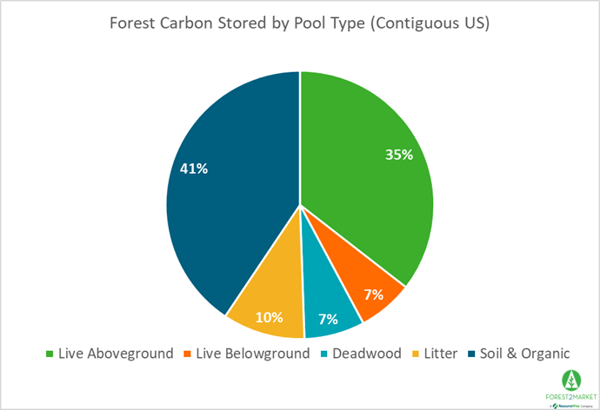
When considering the cyclical nature of a forest, this data makes sense. While the average lifecycle of a single mature tree may be 30-100 years on active timberland, the lifecycle of the forest surrounding that tree is virtually infinite unless it is impacted by structural land use changes or other catastrophic events. But what about the land—the actual dirt and earth—itself? A 2020 study published by the Annual Review of Environment & Resources provides visibility into the critical processes occurring in the soils and other organic materials below the forest floor, and the roles that the soil microbiome plays in cycling soil organic carbon.
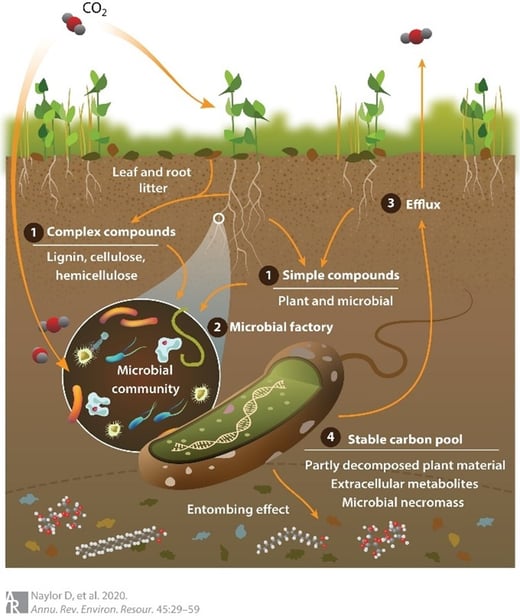
“Carbon dioxide in the atmosphere is fixed by plants (or autotrophic microorganisms) and added to soil through processes such as (1) root exudation of low-molecular weight simple carbon compounds, or deposition of leaf and root litter leading to accumulation of complex plant polysaccharides. (2) Through these processes, carbon is made bioavailable to the microbial metabolic "factory" and subsequently is either (3) respired to the atmosphere or (4) enters the stable carbon pool as microbial necromass. The exact balance of carbon efflux versus persistence is a function of several factors, including aboveground plant community composition and root exudate profiles, environmental variables, and collective microbial phenotypes (i.e., the metaphenome).”
When looking closer at the Carbon Analysis 360 data by region for these two pool types, we see some disparities between the two metrics. Most notably, Eastern North America has significantly more carbon stored in Soil & Organic materials than the other two regions. What are some likely explanations for these discrepancies?
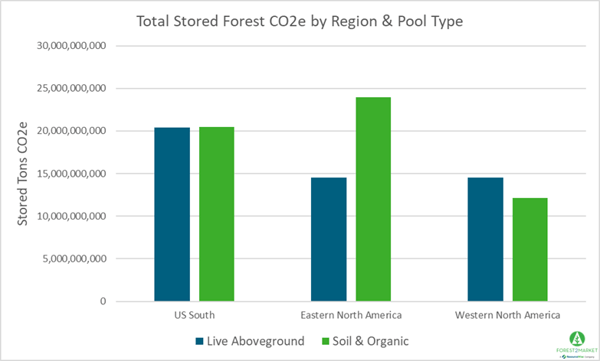
To uncover some answers, we first need to look at total forestland acres in each region, which will help explain some of the volume differences. The US South actually has 50% more total forestland acres (most of which are privately owned) than the PNW, and 38% more than Eastern North America.
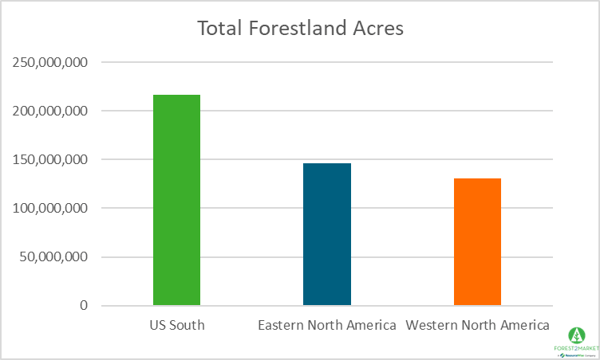
However, as we noted in our last post on this topic, even though the PNW is known for its vast national forests, much of the tree inventory is contained in the Westside territory, which makes up just a portion of the entire region. The chart below illustrates the outsized impact the Westside has on total stored forest CO2e per acre compared to the other forested regions.
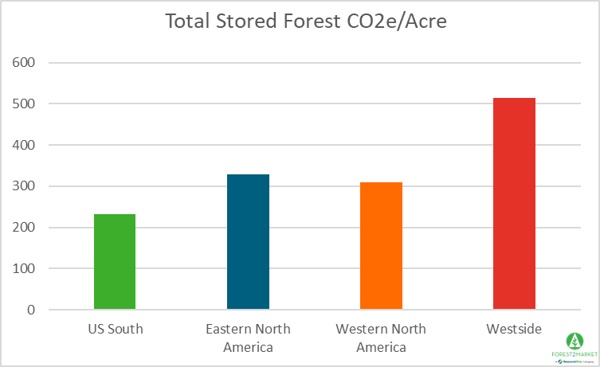
Since forest ecosystems are extremely complex and vary significantly from region to region, there are also a few nuanced observations worth noting.
- Forest soils are vital for forest health and growth, providing physical support, nutrients and moisture for growth, and storing not only carbon, but also the necessary elements for recycling back to trees. Soils are influenced by forest vegetation, climate, parent material, and other organisms unique to their geographies.
- Notice the parity between Live Aboveground and Soil & Organic carbon stored in Southern forests, where nearly 50% of the inventory is comprised of pine species. One reason for this is the even-aged management of most of the working timberland in the region—which is managed via harvest regimes that involve planting, thinning and clearcutting, before repeating the cycle—as well as the unique clay and sandy soil types that are widespread throughout the region.
- Now, notice the discrepancy between Live Aboveground and Soil & Organic carbon stored in Eastern North American forests. One reason for this is the uneven-aged management of most of the working timberland in the region—a majority of which is also comprised of deciduous/hardwood species. Unlike Southern forests, most timber tracts in the Northeast and Lake States are not established as plantations, thinned and clearcut. Rather, multiple forest products (pulpwood, small logs and sawtimber) are selectively removed from the stand during a harvest, so the forest remains in perpetual, but varied stages of growth. Soil types in this region also tend to be gravelly/loamy with mineral deposits—very different when compared to the sand/clay soil types across the South.
So, which forest carbon pool types store the most carbon in the contiguous US?
With 76% of current stored forest carbon, Live Aboveground and Soil & Organic pool types are the high performers of the group. While the other pool types are important to the lifecycle of forests as carbon sinks, they simply can’t do the heavy lifting that actual trees and the soils that support them are capable of doing.
Carbon Analysis 360 provides unparalleled insights into the forest carbon datasets that are poised to drive decision-making going forward. Users have the flexibility to analyze the forest carbon metrics that matter most to them and refine all of the unique platform data filtered down to the county level, as well as downloaded and exported. Talk to a Forest2Market representative today to arrange a demo.


